Key takeaways:
- Community housing development emphasizes the importance of building relationships, ensuring security, and enhancing quality of life beyond just constructing homes.
- Design workshops facilitate collaboration among diverse stakeholders, allowing for innovative solutions while ensuring all community voices are heard.
- Attending workshops offers networking opportunities that can lead to significant collaborations and partnerships, enhancing individual design perspectives.
- Practical applications of workshop knowledge in community projects are crucial, highlighting the importance of communication and adaptability in addressing community needs.
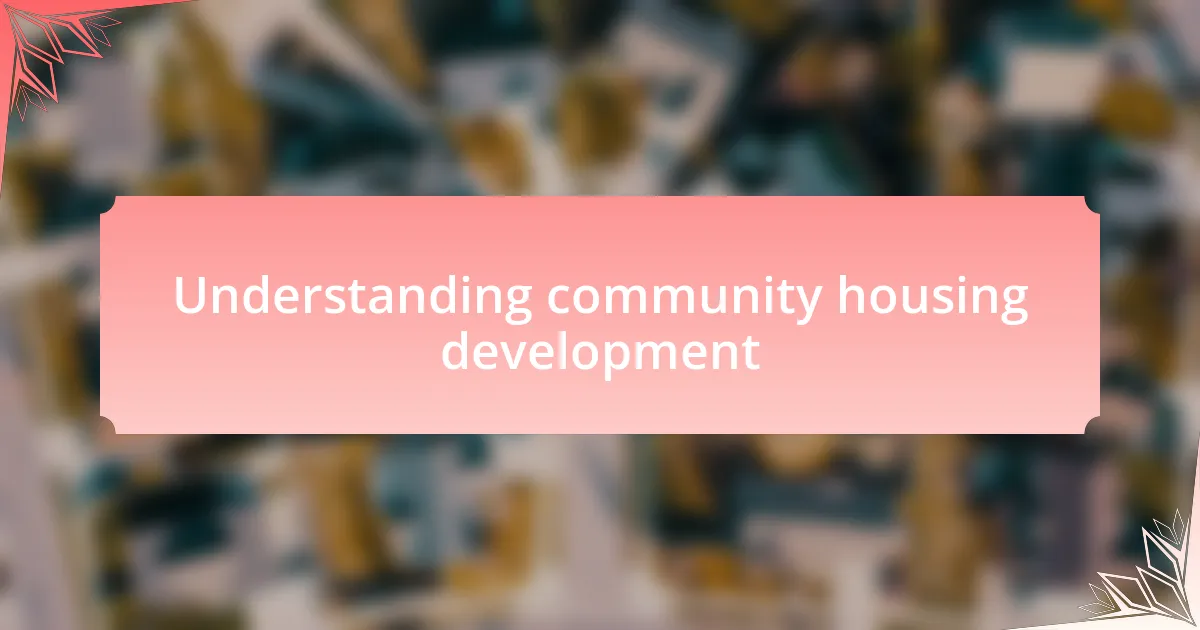
Understanding community housing development
Community housing development is a vital aspect of creating inclusive and sustainable living environments. I remember the first time I participated in a community meeting about housing needs; the passion and concern in the room were palpable. It struck me how deeply housing impacts not just shelter, but also the sense of belonging and identity within a community.
When I reflect on what community housing actually means, it goes beyond just building houses. It’s about fostering relationships, providing security, and enhancing quality of life for residents. Have you ever thought about how a simple home can transform lives? I’ve witnessed firsthand how access to stable housing empowers individuals and strengthens communities as a whole.
Moreover, understanding community housing development means grasping the complexities involved in balancing affordability, sustainability, and social equity. I often ponder how these elements interact and shape our neighborhoods. In my experience, engaging with various stakeholders, from residents to local governments, reveals unique perspectives and solutions that are essential for creating livable communities.
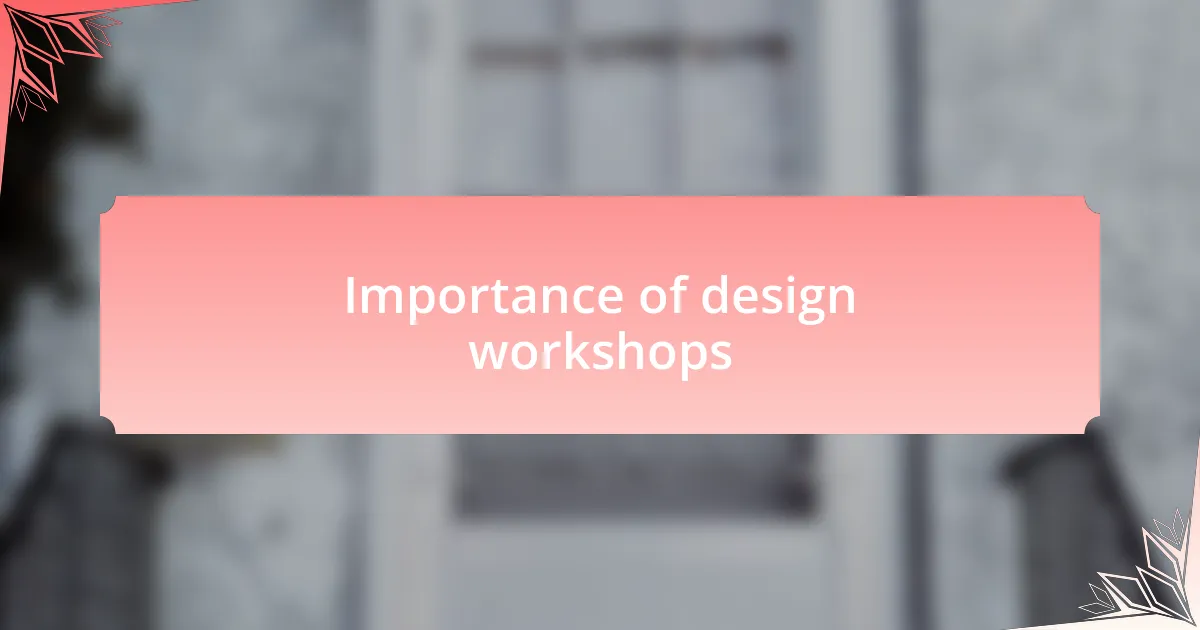
Importance of design workshops
Design workshops serve as essential forums where creative ideas converge, allowing community members to voice their visions for housing development. During my first workshop, I was struck by the energy in the room as participants, with diverse backgrounds and experiences, collaborated to brainstorm innovative solutions. It became clear to me how these workshops empower individuals to actively shape their living environments, fostering a sense of ownership and pride.
The importance of design workshops extends to bridging gaps in understanding between stakeholders. I remember a moment when a local resident shared their concerns about accessibility features in a design. It was eye-opening to witness the immediate impact of their input on the architectural plans. This highlights how design workshops create a platform for dialogue, ensuring that all voices are heard and respected in the planning process.
Additionally, these workshops encourage creativity and exploration, which are crucial in addressing the unique challenges faced by different communities. I often find myself inspired by the innovative ideas that emerge when various perspectives are brought to the table. Have you ever considered how a simple concept, like community gardens or shared spaces, can enhance social interaction and connectivity? Through design workshops, we can transform abstract ideas into tangible solutions that meet the specific needs of our neighborhoods.
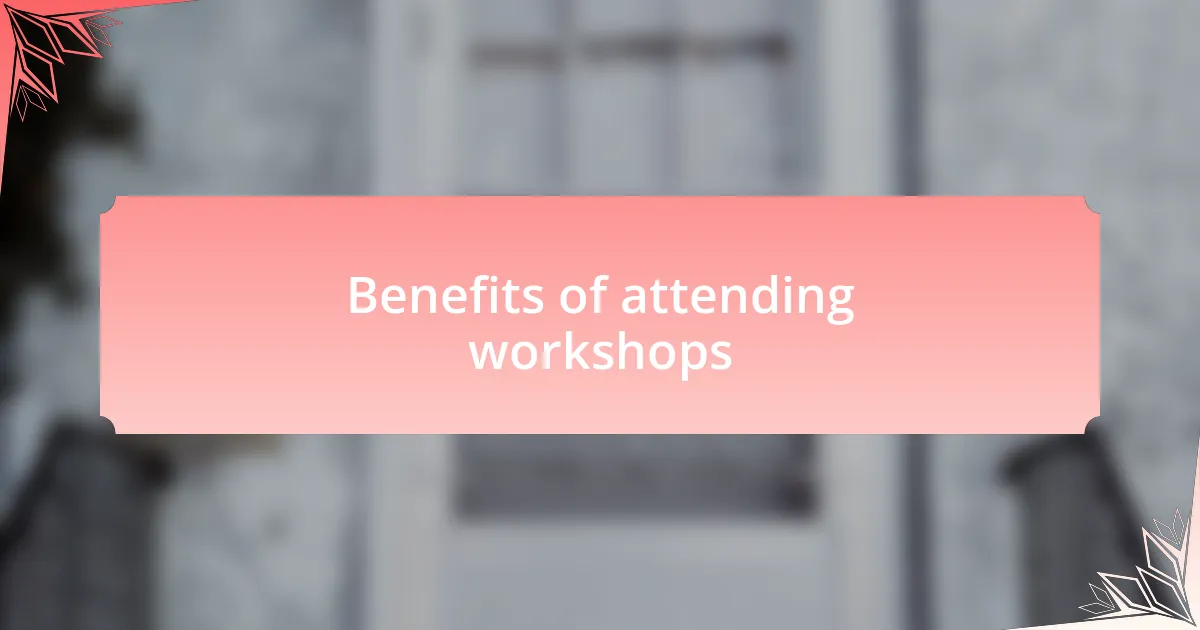
Benefits of attending workshops
Attending design workshops offers an invaluable opportunity to expand one’s network. I vividly remember meeting a local architect during a session who was passionate about sustainable housing. Our conversation sparked a collaboration that ultimately led to the creation of a community solar initiative. Have you ever encountered someone who shifted your perspective in such a way? Those unexpected connections can open doors to new ideas and partnerships that may have otherwise remained unexplored.
One of the most rewarding aspects of workshops is the hands-on experience they provide. During a recent event, we were tasked with creating scale models of proposed housing designs. I felt a rush of excitement as we shaped our ideas into physical representations. Engaging in this tactile process allowed me to see how theory translates into practice. It was compelling to witness the transformation of abstract concepts into something visually impactful, reinforcing my belief in the power of collaboration.
Moreover, the feedback received is invaluable. After presenting our group’s design, we received critiques from both peers and seasoned professionals. Initially, I felt nervous about the feedback, but it was enlightening to see others’ perspectives on our work. This constructive criticism not only improved the project but also provided deeper insights into my own design process. Isn’t it fascinating how receiving feedback can turn uncertainty into growth? Each workshop enriches my understanding and refines my approach, making it clear why I consistently seek out these opportunities.
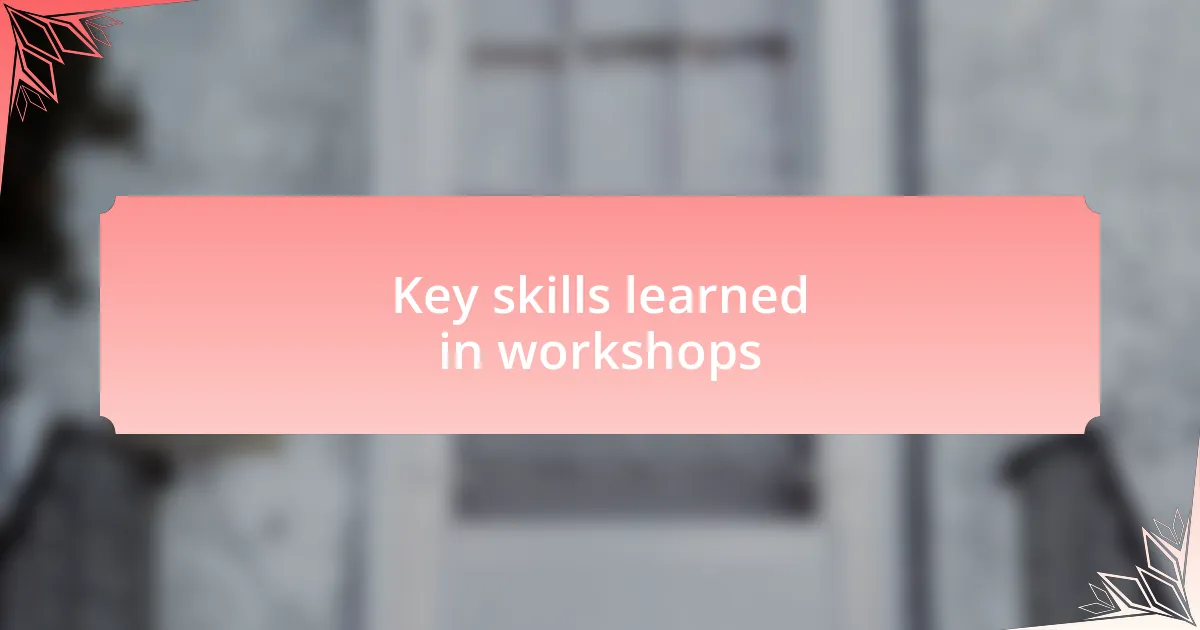
Key skills learned in workshops
Participating in design workshops has truly sharpened my problem-solving skills. I recall one exercise where we faced a real-world housing issue and had to brainstorm potential solutions within a limited timeframe. The pressure was palpable, but it taught me how to think on my feet and collaborate effectively under stress. Have you ever felt a rush when confronted with a challenge? That moment of urgency can ignite creativity in remarkable ways.
Another critical skill I gained was mastering the art of visual communication. During one workshop, we were encouraged to present our ideas solely through sketches and diagrams. I remember feeling vulnerable without words to support my concepts, but it forced me to convey my vision through imagery. This experience highlighted the power of visuals in storytelling—something that is essential in design. How often do we rely on written explanations, overlooking the impact that a single image can have?
Lastly, I learned the importance of adaptability. One memorable session required us to pivot our design based on real-time feedback from community members. Initially, it was disheartening to reshape what I thought was a perfect plan, yet it opened my eyes to the needs of the community. Embracing a flexible mindset is vital in the design process, wouldn’t you agree? Navigating these shifts not only enhances a project but also deepens my connection with the community I aim to serve.
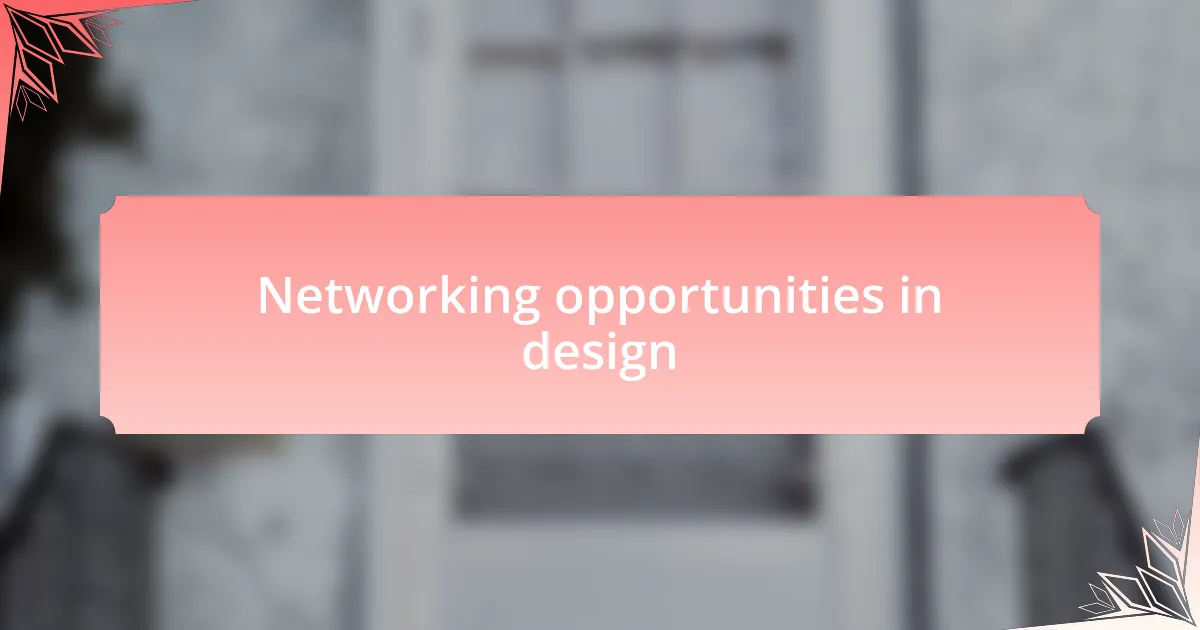
Networking opportunities in design
When attending design workshops, I discovered that networking isn’t just a side benefit; it’s one of the most rewarding aspects of the experience. I vividly recall a casual conversation over coffee with a fellow designer who later became a collaborator on a significant housing project. We exchanged ideas and contacts, and it all started with a simple chat that ignited not just our friendship, but also opportunities for growth. Have you ever considered how many doors can open from a single discussion?
Additionally, the diversity of participants in these workshops has been eye-opening. One session featured designers from various backgrounds, each bringing unique perspectives. I remember sharing insights with an architect specializing in sustainable practices, which sparked a series of brainstorming sessions that pushed my design thinking in unexpected directions. Isn’t it fascinating how engaging with someone from a different field can inspire new ideas?
What struck me the most was the atmosphere of collaboration shared among attendees. During one workshop, we formed small groups to tackle complex design challenges. Although it was competitive, the camaraderie was palpable, and we all left with not only new contacts but also potential partnerships. Who would have thought that a competitive setting could foster such strong connections? It’s a reminder that in design, collaboration can be as vital as creativity.
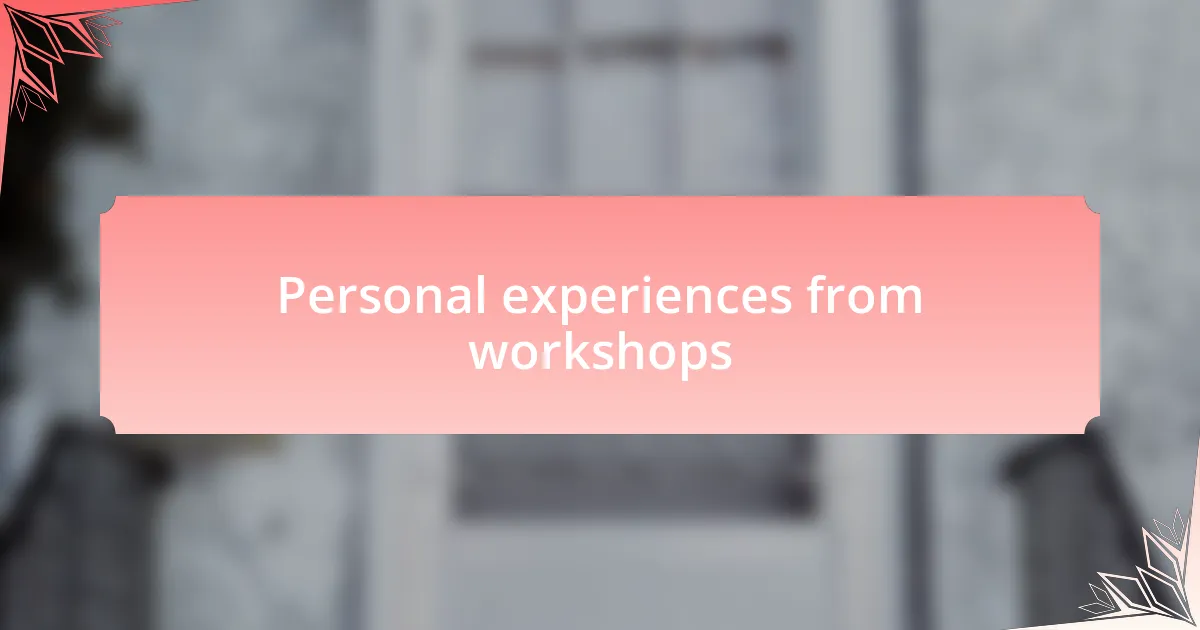
Personal experiences from workshops
Participating in design workshops has profoundly shaped my perspective on creativity and teamwork. I vividly recall a session where we were tasked with a role-playing exercise, designating each participant as a different stakeholder in a housing project. Embracing this perspective not only challenged my assumptions but also evoked a deeper empathy for diverse community needs. Have you ever felt that rush of realization when you step outside your own experience and see things through another’s eyes?
One of my most memorable moments came during a hands-on design sprint, where we were pushed to think outside the box. I felt a surge of adrenaline as we raced against the clock, brainstorming iterative designs for communal spaces. The thrill wasn’t just in the competition; it was realizing how collaboration can elevate a simple idea into something truly innovative. It left me wondering—can stress actually be a catalyst for creativity?
In another workshop, I shared my struggles with a particular design flaw in a community housing model I was developing. To my surprise, several participants offered constructive feedback and even shared their own past challenges. I left feeling not just validated in my experiences but also armed with new tools and strategies. Isn’t it incredible how vulnerability can lead to meaningful growth and support from peers?
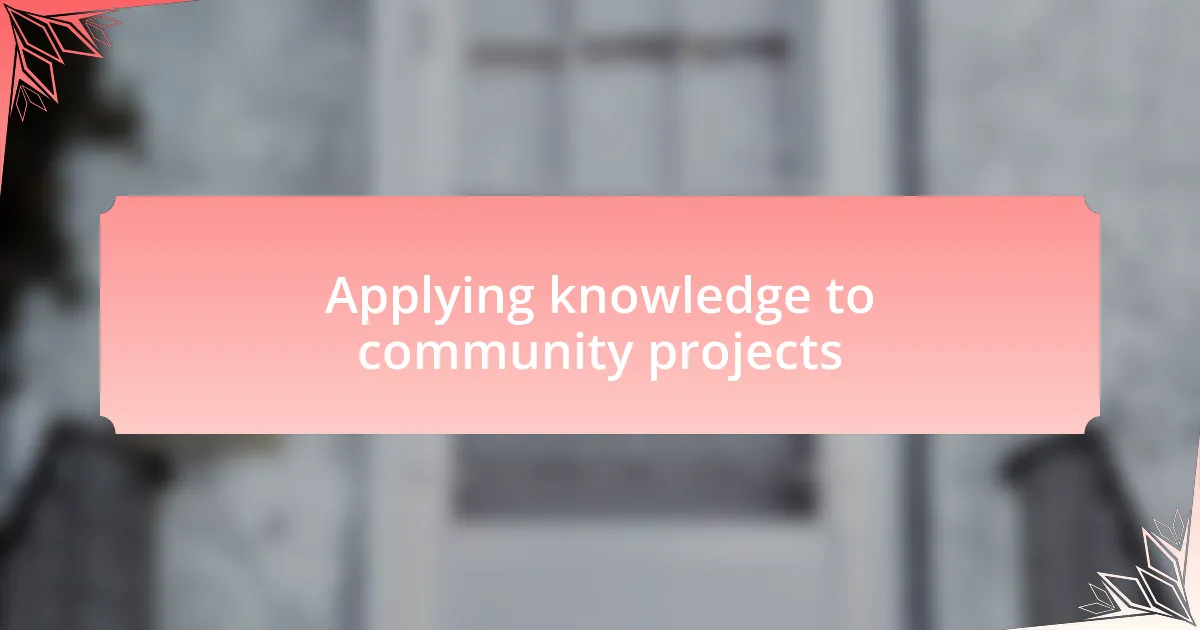
Applying knowledge to community projects
Applying knowledge to community projects often requires a careful blend of theory and practice. In one of my design workshops, we discussed community resource allocation, and it struck me how vital it is to consider real-world implications. The discussions inspired me to rethink how I approach resource distribution in my own projects. Have you ever considered how small adjustments in planning can drastically improve community engagement and well-being?
I remember implementing a design concept we brainstormed during a workshop. It revolved around creating multi-functional spaces that adapted to various community needs. As I incorporated these ideas into my project, I felt a surge of excitement. Seeing the positive response from community members confirmed my belief in the power of collaborative design. Doesn’t it feel amazing when your work resonates with those it’s meant to serve?
Furthermore, I realized that communication plays a crucial role in applying this newfound knowledge. During one session, we practiced presenting our ideas to different stakeholders, which highlighted the significance of tailoring messages for diverse audiences. This practice became invaluable when I sought feedback on my community designs. It’s fascinating how expressing ideas in accessible ways can foster connections and encourage constructive dialogues. Have you noticed how the right words can bridge gaps in understanding?